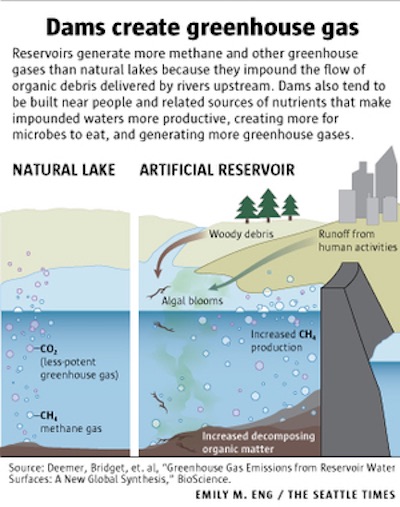forum
library
tutorial
contact

Hydropower Isn't Carbon Neutral
After All, WSU Researchers Say
by Lynda V. Mapes
Seattle Times, September 28, 2016
|
the film forum library tutorial contact |

|
Hydropower Isn't Carbon Neutral
by Lynda V. Mapes
|
Washington State University researchers have learned that reservoirs produce
much more methane, a potent greenhouse gas, than previously understood.
 Think hydropower is carbon neutral? You have another think coming, Washington State University researchers have learned.
Think hydropower is carbon neutral? You have another think coming, Washington State University researchers have learned.
In their paper to be published next week in BioScience, the researchers reported that reservoirs of all sorts are important sources of the potent greenhouse-gas methane. The gas is produced by decomposing organic material underwater.
While much attention has been paid to the effects of dams on fisheries and the natural form and function of rivers, little notice has been taken of the emissions they cause. Usually thought of as carbon-neutral sources of energy, hydropower dams, while far cleaner than fossil fuel for generating power, nonetheless are sources of carbon pollution.
Reservoirs not only produce methane, but they generate more greenhouse gases than natural lakes, found research associate Bridget Deemer and John Harrison, associate professor of biogeochemistry at WSU Vancouver.
That is for two reasons: Dams on rivers trap organic materials from a large cachement area continually delivered by the free-flowing river upstream. Secondly, dams tend to be located closer to human presence, where nutrient loading from fertilizers used in agriculture, manure from farm animals, and septic and sewer systems boosts production of algae and other organic life in the water. That means more for microbes to eat -- and more methane produced by the microbes.
In their synthesis review of 100 research papers published on the topic since 2000, the researchers and their collaborators also established that methane emissions were about 25 percent higher per acre than previously understood on a given reservoir, said Deemer, lead author on the paper. That was because the researchers looked not only at methane diffused from the surface of lakes, but at gas in bubbles rising to the surface.
"I was excited about what we found," Deemer said.
 Collectively, reservoirs created by dams produce about 1.3 percent of total annual global human-caused emissions. That's as much greenhouse gas as other significant human sources, such as rice cultivation and biomass burning, the researchers found.
Collectively, reservoirs created by dams produce about 1.3 percent of total annual global human-caused emissions. That's as much greenhouse gas as other significant human sources, such as rice cultivation and biomass burning, the researchers found.
The findings are expected to shift the way the Intergovernmental Panel on Climate Change tallies greenhouse-gas production by human activities to include flooded lands in those calculations, Harrison said. Previously -- unlike rice cultivation and biomass burning -- emissions from flooded lands were not counted.
More than 1 million dams constructed globally have provided a variety of services important to people. But their environmental effects are profound, from blocked migration of fish, to impoundment of woody debris and other organic materials carried by rivers. Add to the list the generation of potent greenhouse gases, so called because they block the radiation of heat from the Earth and reradiate it to the atmosphere, raising the global average temperature of the planet.
Per molecule, methane is far more efficient at trapping and reradiating heat to the atmosphere than carbon dioxide, also adding to the importance of the findings.
Researchers are continuing their work to investigate the degree to which management of reservoirs also contributes to greenhouse-gas production, Harrison said. Lower reservoir levels reduce water pressure in the lake, which releases more gas, in the same way that taking the cap off a soda bottle releases bubbles of carbon dioxide for that soda-pop tang.
The synthesis paper is the largest of its kind to date, pulling together findings not only from hydropower reservoirs, but any sort, such as reservoirs for flood control, navigation or irrigation. The study also is the first to examine the flow of all three major greenhouse gases -- carbon dioxide, methane and nitrous oxide -- from reservoirs to the atmosphere.
The contribution of greenhouse gases from reservoirs is sure to increase.
While Washington state leads the world in dam removal -- most notably on the Elwha River -- globally, a boom in dam construction is under way.
At least 3,700 major hydropower dams are either planned or under construction, primarily in countries with emerging economies, according to a paper published in Aquatic Sciences in 2015 by Christiane Zarfl and A.E. Lumsdon at the Leibniz-Institute of Freshwater Ecology and Inland Fisheries in Berlin.
Dam construction on such a grand scale, primarily in Southeast Asia, Africa and South America, is predicted to reduce the planet's remaining free-flowing large rivers by 21 percent, those authors found.
learn more on topics covered in the film
see the video
read the script
learn the songs
discussion forum
